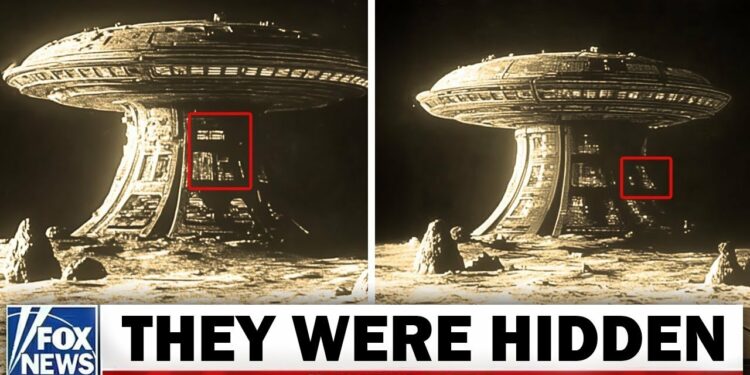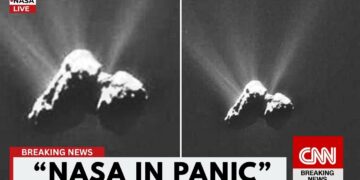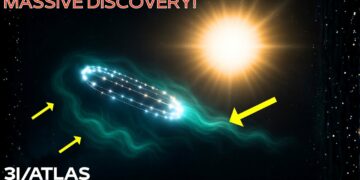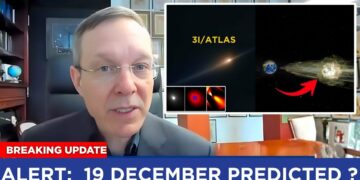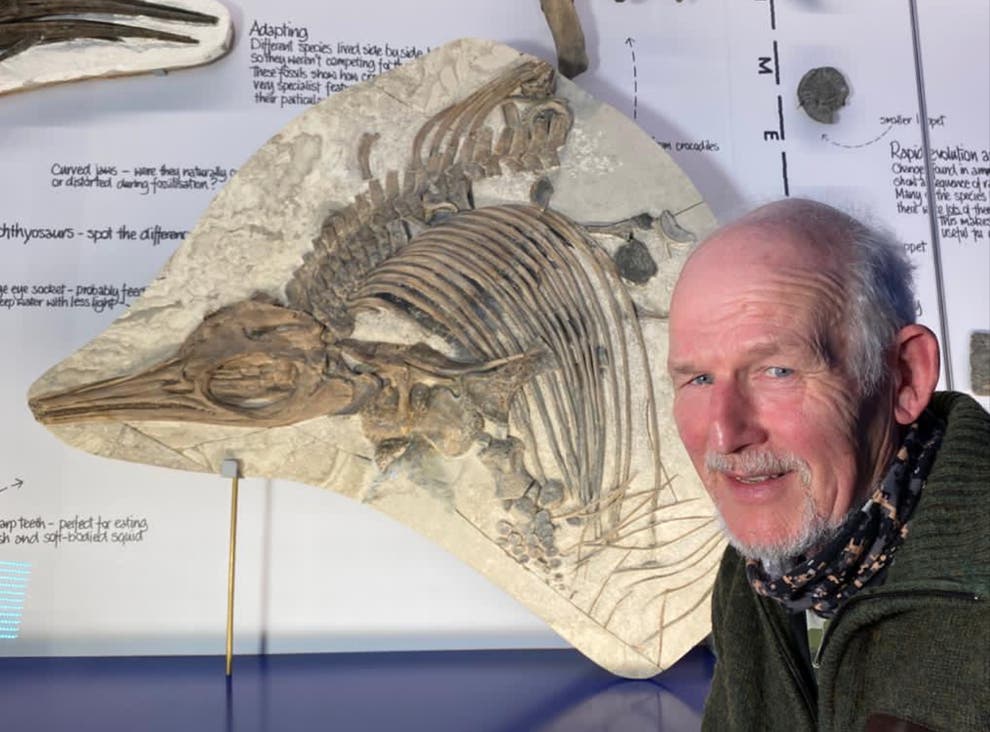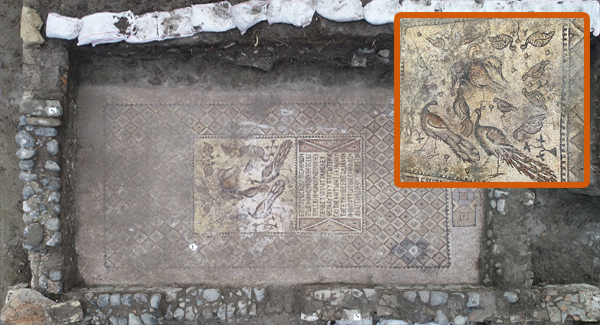The Cassini mission, a landmark in space exploration, left an extraordinary legacy, particularly in its revelations about Saturn and its moon Enceladus, a prime candidate for extraterrestrial life. When Cassini plunged into Saturn’s atmosphere in 2017, scientists believed they had uncovered all the planet’s secrets. However, years later, advanced quantum artificial intelligence revealed something astonishing: bizarre mathematical patterns embedded in Saturn’s clouds that defy natural explanation. Could Cassini have detected an intelligent presence? Was something observing us from Saturn? And why has this discovery been shrouded in secrecy?
A Mission Beyond Expectations
Launched in 1997, Cassini was a marvel of engineering—a bus-sized spacecraft equipped with 12 scientific instruments designed to study Saturn’s complex systems. Over its 13-year mission, it unveiled Saturn’s wonders: the enigmatic hexagonal storm at the north pole, a six-sided weather pattern larger than Earth; the intricate beauty of Saturn’s rings; and the moons Titan, with its methane lakes and thick atmosphere, and Enceladus, an icy world with plumes of water from a subsurface ocean, making it a prime target in the search for life.
As Cassini’s fuel dwindled, NASA chose to end the mission with a controlled dive into Saturn’s atmosphere to avoid contaminating potentially habitable moons like Enceladus. In its final months, Cassini executed daring orbits between Saturn and its innermost ring, capturing unprecedented high-resolution images of the planet’s atmosphere, magnetic fields, and rings. These images provided insights into the rings’ age and the atmosphere’s composition. Yet, subtle anomalies—distortions, repeating geometric patterns, and unusual symmetries in the chaotic clouds—went largely unnoticed, dismissed as camera artifacts or transmission errors and archived for future study.
The Overlooked Anomalies
The scientific community initially focused on Cassini’s broader findings: the rings’ structure, atmospheric behavior, and moon discoveries. Amid the flood of data, peculiar patterns in the images—geometric echoes, unnatural symmetries, and precise mathematical ratios—were overlooked or attributed to equipment quirks. Some researchers noted these anomalies in internal reports, documenting consistent cloud patterns, unusual pixel distributions, and recurring mathematical ratios, but without advanced tools or context, these were filed away as unexplained phenomena. Human tendency to see patterns (pareidolia) further diminished their significance, and the images were archived, their secrets hidden in plain sight.
The Quantum Breakthrough
By 2025, quantum computing had matured, offering unparalleled processing power. A private research lab specializing in astronomical data analysis used a quantum AI system to enhance noisy images, selecting Cassini’s final Saturn images as test subjects. Designed to detect subvisual patterns, the AI analyzed pixel data and quantum-level correlations across multiple frames. Instead of clearer cloud bands or ring structures, it revealed a consistent, structured pattern across images—symmetrical, mathematically precise, and appearing to shift as if responding to Cassini’s movements.
Initial suspicions of algorithmic errors were dispelled through rigorous testing. The patterns persisted across different frames, camera angles, and analytical techniques, ruling out glitches. As one researcher noted, these findings suggested either an unknown atmospheric phenomenon defying physics or the presence of something observing Cassini during its final approach.
Patterns Emerge from the Static
Further analysis revealed complex mathematical sequences: prime numbers, Fibonacci spirals, and proportions matching the golden ratio and pi to remarkable precision. These sequences, embedded in Saturn’s clouds, mirrored patterns theorized for interstellar communication, as used in humanity’s Voyager Golden Records. The patterns evolved as Cassini approached Saturn, becoming more defined and complex in its final hours, suggesting an active response to the spacecraft’s presence. They moved against atmospheric currents, maintaining mathematical consistency, as if deliberately projected into the visible spectrum.
Experts in mathematics, physics, and cryptography confirmed the patterns’ intentional design, with sequences resembling a language-like structure. One sequence described a three-dimensional geometric form, dubbed “the key” or “the address,” though its purpose remained unclear. The patterns appeared to react to Cassini’s movements, suggesting an intelligence attempting communication.
Saturn: The Perfect Hiding Place
Why Saturn? The planet’s anomalies—emitting 2.3 times more heat than it receives, a perfectly aligned magnetic field, and complex ring structures—make it an enigma. The AI-detected patterns aligned with regions of magnetic field fluctuations, where human instruments struggle to obtain clear readings, suggesting a deliberate choice of “blind spots” for concealment. Saturn’s dynamic atmosphere, with its shifting ammonia and water vapor clouds, provided an ideal canvas for patterns to form and dissolve, unnoticed without advanced analysis.
This led researchers to speculate that Saturn was chosen as a message board, visible only to a civilization with sufficient technological sophistication. The patterns may have been present during earlier missions like Pioneer 11 and Voyager, waiting for a spacecraft like Cassini to capture them with adequate fidelity.
The Missing 12th Frame
Among the discoveries, the mystery of the 12th frame stands out. Cassini’s logs confirm it captured 12 images during its final descent, but the last image was unreadable—intact but scrambled, as if deliberately encoded. Despite extensive efforts, including specialized quantum algorithms, the image remained undecodable. Some theorized it was a test, locked until humanity advances further, or contained undeniable evidence of an intelligent presence, intentionally obscured to prevent premature revelation.
Scientific Community Divided
The discovery sparked intense debate. Astrophysicists noted the patterns’ mathematical precision, aligning with SETI’s criteria for interstellar communication, while planetary scientists highlighted their independence from Saturn’s atmospheric dynamics. Skeptics argued the AI might be creating patterns (digital pareidolia) or that unknown electrochemical processes could explain the structures. The missing 12th frame fueled further controversy, with some seeing it as evidence of deliberate encryption, others as a potential natural explanation. Claims of similar patterns in Voyager images suggested a decades-long presence, intensifying the divide.
The Unexpected Silence
As debate peaked, discussion of the patterns abruptly ceased. The quantum AI lab went silent, its researchers redirected to unrelated projects, and their algorithms reportedly overwritten. Scientists stopped discussing the findings, conference presentations were canceled, and submitted papers were withdrawn. Rumors of funding cuts, nondisclosure agreements, and official pressure circulated. NASA claimed all Cassini data was publicly available, yet accessing the specific images became difficult. This silence suggested either scientific caution or a concerted effort to suppress a groundbreaking discovery.
An Unresolved Mystery
Today, the Cassini images remain in archives, though accessing the complete dataset is challenging. Independent researchers continue to verify aspects of the patterns using private resources, but the quantum AI analysis has not been fully replicated. Did Cassini capture evidence of a non-human intelligence in Saturn’s clouds, or did quantum AI amplify human pattern-seeking tendencies? As new missions to Saturn are planned, the truth may soon come to light.

